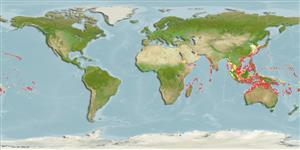Classification / Names
Common names from other countries
Main reference
Size / Weight / Age
Max length : 200 cm TL male/unsexed; (Ref. 5578)
Length at first maturity
Lm ?, range 91 - 120 cm
Environment
Marine; brackish; reef-associated; amphidromous (Ref. 51243); depth range 20 - 75 m (Ref. 37816)
Climate / Range
Subtropical, preferred ?; 35°N - 25°S, 7°E - 134°W
Distribution
Indo-Pacific: Persian Gulf (Ref. 68964), Red Sea and East Africa to the Hawaiian Islands and the Tuamoto Archipelago. North to Japan and south to Australia. Apparently rare or absent in the more easterly groups. Also eastern Mediterranean (through the Suez Canal).
Countries | FAO areas | Ecosystems | Occurrences | Introductions
Short description
Dorsal
spines
(total): 0;
Dorsal
soft rays
(total): 0;
Anal
spines: 0;
Anal
soft rays: 0. A small shark with a short, bluntly rounded snout, oval eyes, and narrow-cusped teeth; 2nd dorsal fin large; no interdorsal ridge (Ref. 5578). Yellow-brown above, white below; all fins conspicuous with black or dark brown tips also anterior and posterior dark edging on pectoral fins and upper lobe of caudal fin; a prominent black tip of first dorsal fin set off abruptly by a light band below it; a conspicuous dark band on flanks, extending rearward to pelvic fins (Ref. 9997).
IUCN Red List Status (Ref. 115185)
Threat to humans
Traumatogenic (Ref. 4690)
Human uses
Fisheries: commercial; aquarium: public aquariums
More information
ReferencesAquacultureAquaculture profileStrainsGeneticsAllele frequenciesHeritabilityDiseasesProcessingMass conversion
Tools
Special reports
Download XML
Internet sources
Estimates of some properties based on models
Phylogenetic diversity index
PD50 = 0.5000 many relatives (e.g. carps) 0.5 - 2.0 few relatives (e.g. lungfishes)
Trophic Level
3.9 ±0.4 se; Based on diet studies.
Resilience
Very Low, minimum population doubling time more than 14 years (Fec=2)
Vulnerability
High to very high vulnerability (67 of 100)
Price category
